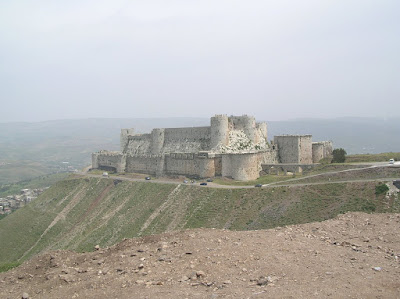The taxi dropped us off in the middle of what appeared to be nowhere, except for a two-storey Starbucks with a drive-thru. This Starbucks had a huge outdoor terrance on the second floor and its own very large parking lot. (We had been to a Starbucks the day before to have a taste of home. After spending $6.00 for two coffees, we did not plan to do that again. This is the price of a significant meal for two in Amman.) Beside the Starbucks, was the Blue Fig. The Blue Fig was simlar to one of the restuarants in the Distillery District, with very high celings and an ultra-modern mixture of glass and black wood. However, the difference was that everyone at their tables were smoking. It was the place to be seen, with the quality of food being secondary. We had an Idonesia pizza, which was a pizza crust with peanut butter, peanuts and slices of beef on top with pieces of tomato and chives -- very original.
It was a very interesting place to go and see how another culture tries to emulate the Western lifestyle. It certainly gives us something to think about how in terms of how we are perceived.
City of Amman from Citadel:

Today, we spent our last day in Amman. This morning we visited the Citadel. It has some excavated ruins of an Umayyad palace, dating from about AD 720, of which the domed audience hall is the most impressive.

There is also an Umayyad Cistern, a Byzantine Basilica from the 6th or 7th century AD and pillars of the Temple of Hercules. On our way up to the Citadel, a half hour hike up the streets, the locals continued to steer our direction quite emphatically. We wondered about some of the directions we were being given as they entailed going up narrow stairs and paths. However, at the end of our journey, we ended up in the Citadel, past the entrance 'fee' booth, much to our surprise and no one's concern.
After our hike back down into the city, we had lunch at the Hashem Restaurant, at which the late King Hussein would sometimes eat. This restaurant is famous for its falafel, french fries, hummus, hummus and beans, tea and nothing else. We had their specialties -- served with bread, raw onions and mint leaves.
Meal at the Hashem Restaurant

This evening we plan to have our last supper in Amman, Jordan at the Al-Rashid Court Cafe, also known as the Eco-Tourism Cafe. It is a 1st-floor balcony from where we can observe the chaos of the Downtown area, while enjoying the last few hours spent in Jordan.
Tomorrow morning we leave our hotel at 7:00 a.m. to catch our plane back home to Toronto via New York.










































